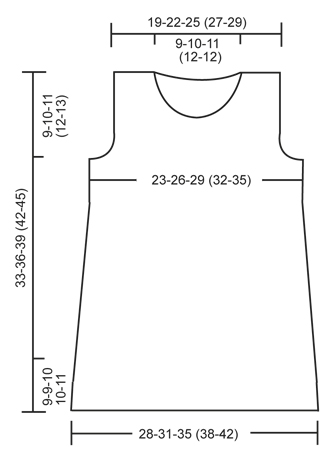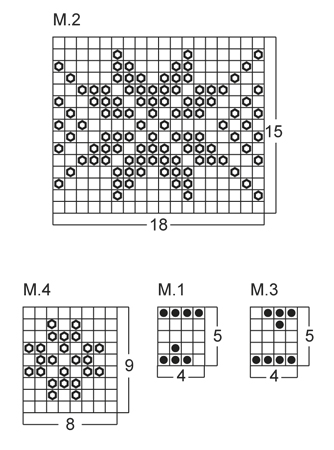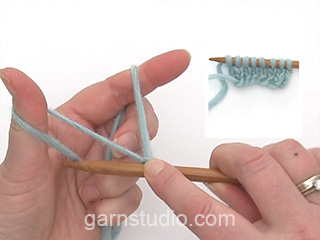Sweet Violette |
||||||||||
|
|
||||||||||
Set of knitted dress and crochet hat for baby and children in DROPS BabyAlpaca Silk or DROPS Safran
DROPS Baby 21-7 |
||||||||||
|
DRESS: PATTERN: See diagrams M.1 - M.4. DECREASE TIP 1 (applies to body): Dec 1 st on each side of marker as follows: Work until 2 sts remain before marker, slip 1 st as if to K, K 1, psso, (marker), K tog the next 2 sts. DECREASE TIP 2 (applies to armholes): Dec 1 st in each side as follows: Work 4 sts in garter st, work the next 2 sts tog (K tog if next st is P, P tog if next st is K), work until 6 sts remain, work the next 2 sts tog (K tog if previous st was P, P tog if previous st was K), 4 sts in garter st. GARTER ST (back and forth on needle): K all rows. SEED ST (back and forth on needle): 1st row: * K 1, P 1 *, repeat from *-*. 2nd row: K over P and P over K. Repeat 2nd row. BUTTON HOLE: Bind off for button hole on left back piece by working 3rd and 4th st from mid back tog, make 1 YO. ---------------------------------------------------------- BODY: Worked in the round on circular needle. Cast on 144-164-180 (200-216) sts with babyAlpaca Silk light old rose or Safran mauve on circular needle size 2.5 mm / US 1or2. K for approx. 2.5 cm / ⅞", then P 1 round = folding edge, measure piece from here. REMEMBER THE GAUGE! K 2 more rounds and insert a marker in each side (= 72-82-90 (100-108) sts between markers on front and back piece). Then work diagram M.1 1 time vertically - Dec 0-2-0 (2-0) sts evenly on last round (5th round in diagram M.1) = 144-162-180 (198-216) sts. Now work diagram M.2 1 time vertically - Dec 0-2-4 (2-4) sts evenly on last round (15th round in diagram M.2) = 144-160-176 (196-212) sts. Then work diagram M.3 1 time vertically. Continue in stockinette st with BabyAlpaca Silk light old rose / Safran mauve until piece measures 9-9-10 (10-11) cm / 3½"-3½"-4" (4"-4⅜"). Now dec 1 st on each side of every marker - Read DECREASE TIP 1 above = 4 sts dec on round. Repeat dec like this every 4-4-6 (6-6) rounds a total of 6-6-6 (7-7) times = 120-136-152 (168-184) sts. READ ALL OF THE FOLLOWING SECTION BEFORE CONTINUING. When piece measures 17-19-21 (23-25) cm / 6¾"-7½"-8¼" (9"-9¾") (all dec are now done), work diagram M.1, then M.4 and then M.3 1 time vertically. Then P with BabyAlpaca Silk light old rose / Safran mauve until piece measures 24-26-28 (30-32) cm / 9½"-10¼"-11" (11¾"-12½"). Now bind off 4 sts in each side (i.e. 2 sts on each side of every marker), now divide the piece and finish each part separately. BACK PIECE: = 56-64-72 (80-88) sts. Work next row (= RS) as follows: Work 4 sts in garter st (= edge sts), dec 1 st - Read DECREASE TIP 2 above, work in seed st - Read explanation above - until 6 sts remain, dec 1 st - Read DECREASE 2 above, finish with 4 sts in garter st. Repeat dec inside 4 sts in garter st in each side on every row from RS like this a total of 3-3-3 (5-6) times = 50-58-66 (70-76) sts. Continue with seed st (with 4 sts in garter st in each side until finished measurements) until piece measures 27-29-31 (34-37) cm / 10⅝"-11⅜"-12¼" (13⅜"-14½"). Now insert a marker between the 2 middle sts, and divide the back piece in 2 parts from RS as follows: Slip the sts up to 2 sts before marker mid back on a stitch holder. LEFT BACK PIECE: = 27-31-35 (37-40) sts on needle (sts on left side + 2 sts on right side of marker mid back seen from RS). Continue in seed st and with 4 sts in garter st in each side over these sts. When piece measures 30-33-36 (39-42) cm / 11¾"-13"-14¼" (15¼"-16½"), bind off for button hole - Read BUTTON HOLE above. When piece measures 31-34-37 (40-43) cm / 12 ¼"-13⅜"-14½" (15¾"-17"), bind off from RS the first 12-12-13 (14-15) sts for neck. Then bind off at beg of every row from RS as follows: 2 sts 1 time, 1 st 0-1-1 (1-1) time = 13-16-19 (20-22) sts remain on shoulder. When piece measures 33-36-39 (42-45) cm / 13"-14¼"-15¼" (16½"-17¾"), bind off all sts with K over P and P over K. RIGHT BACK PIECE: Slip sts from stitch holder back on needle and knit up 4 sts behind the first 4 sts towards mid back on left back piece = 27-31-35 (37-40) sts. Continue to work in seed st with 4 sts in garter st in each side as on left back piece but do not bind off for button hole. When piece measures 31-34-37 (40-43) cm / 12 ¼"-13⅜"-14½" (15¾"-17"), bind off for neck as on left back piece but in opposite side. Bind off when piece measures 33-36-39 (42-45) cm / 13"-14¼"-15¼" (16½"-17¾"). FRONT PIECE: = 56-64-72 (80-88) sts. Continue in seed st and bind off for armholes as on back piece. When piece measures 27-30-33 (35-38) cm / 10⅝"-11¾"-13" (13¾"-15"), bind off the middle 12-12-14 (14-16) sts for neck and finish each part separately. Then bind off on next row from neck as follows: bind off 2 sts 1 time, 1 st 4-5-5 (6-6) times = 13-16-19 (20-22) sts remain on shoulder. Bind off when piece measures 33-36-39 (42-45) cm / 13"-14¼"-15¼" (16½"-17¾"). ASSEMBLY: Sew shoulder seams and sew button on to right back piece. Fold in the bottom edge at P round and fasten on WS. CROCHET BORDER: Crochet along the neck line and neck opening with BabyAlpaca Silk heather or Safran amethyst on hook size 2.5mm/C/2 as follows: ROUND 1: * 1 sc, skip approx. 0.5 cm / ¼" *, repeat from *-* and finish with 1 sl st in 1st sc. ROUND 2: * 1 sc in the next 2 sc, ch 3 *, repeat from *-* and finish with 1 sl st in 1st sc. Fasten off. FLOWERS: Ch 4 with BabyAlpaca Silk heather or Safran amethyst and form a ring with 1 sl st in 1st ch. * Crochet 1 sc and 5 dc in ch-ring *, repeat from *-* a total of 3 times and finish with 1 sl st in 1st sc = 3 leaves. Crochet another flower the same way = 2 flowers with 3 leaves. Crochet yet another flower the same way but repeat from *-* a total of 5 times instead of 3 times = 5 leaves. Sew the flowers on to the front piece. -------------------------------------------------------- HAT: CROCHET INFO (applies to hat): All rounds beg with ch 2 (NOTE: not counted as first dc) continue with 1 dc in every st, finish round with 1 sl st in 1st dc at beg of round. COLOR CHANGE: Switch color at the end of round as follows: Crochet 1 sl st with the new color in 1st dc on round. Continue on to next round with the new color. DECREASE TIP: Work 1 dc but wait with last pull through (= 2 sts on hook), then work next dc but on last pull through, pull yarn through all sts on hook = 1 st dec. -------------------------------------------------------- HAT: Worked in the round top down. Ch 4 on hook size 2.5mm/C/2 with BabyAlpaca Silk heather or Safran amethyst and form a ring with 1 sl st in first ch. ROUND 1: ch 2, work 12 dc in ch-ring. Read CROCHET INFO above. ROUND 2: 2 dc in every dc = 24 dc. ROUND 3: * 1 dc in next dc, 2 dc in next dc *, repeat from *-* the entire round = 36 dc. ROUND 4: * 1 dc in the next 2 dc, 2 dc in next dc *, repeat from *-* the entire round = 48 dc. ROUND 5: * 1 dc in the next 3 dc, 2 dc in next dc *, repeat from *-* the entire round = 60 dc. Continue to inc 12 new sts on the round like this by working 2 dc in next st after every 4, 5, 6 sts etc. until there are 108-108-120 (120-132) sts on round. Continue with 1 dc in every st until piece measures 11-12-13 (14-15) cm / 4⅜"-4¾"-5⅛" (5½"-6") (or desired length). Then dec 12 sts evenly on round - Read DECREASE TIP above = 96-96-108 (108-120) sts, and now switch to BabyAlpaca Silk light old rose or Safran mauve - Read COLOR CHANGE above. Continue with 1 dc in every st until piece measures 15-16-17 (18-19) cm / 6"-6¼"-6¾" (7"-7½") and switch to BabyAlpaca Silk heather or Safran amethyst after the last round. Work 1 round with 1 sc in every dc. Work next round as follows: * 1 sc in the next 2 sc, ch 3 *, repeat from *-* and finish with 1 sl st in 1st sc. Fasten off. LARGE FLOWER: Worked in the round. Ch 4 with BabyAlpaca Silk light old rose or Safran mauve and form a ring with 1 sl st in 1st ch. ROUND 1: * 1 sc in ch-ring, ch 3 *, repeat from *-* a total of 3 times and finish with 1 sl st in 1st sc from beg of round = 3 ch-spaces. ROUND 2: Crochet as follows in every ch-space: 1 sl st, 5 dc and 1 sl st = 3 leaves. Turn piece - work next round on the back of the flower. ROUND 3: ch 1, work 1 sc in first sc from 1st round,* ch 4, work 1 sc at the bottom in the middle of next leaf from 2nd round, ch 4, 1 sc in next sc from 1st round *, repeat from *-* until 5 ch spaces have been worked. Finish with ch 4 and 1 sl st in 1st sc on round = 6 ch spaces in total. Turn piece - work next round on the front of the flower. ROUND 4: Crochet as follows in every ch space: 1 sl st, 6 dc and 1 sl st = 6 leaves. Fasten off. SMALL FLOWER: Worked in the round. Ch 4 with BabyAlpaca Silk heather or Safran amethys and form a ring with 1 sl st in 1st ch. * Crochet 1 sc and 5 dc in ch-ring *, repeat from *-* a total of 3 times and finish with 1 sl st in 1st sc = 3 leaves. Fasten off. ASSEMBLY: Sew the flowers on to the hat. |
||||||||||
Diagram explanations |
||||||||||
|
||||||||||

|
||||||||||

|
||||||||||
|
Have you made this or any other of our designs? Tag your pictures in social media with #dropsdesign so we can see them! Do you need help with this pattern?You'll find tutorial videos, a Comments/Questions area and more by visiting the pattern on garnstudio.com. © 1982-2024 DROPS Design A/S. We reserve all rights. This document, including all its sub-sections, has copyrights. Read more about what you can do with our patterns at the bottom of each pattern on our site. |
||||||||||































































Comments / Questions (18)
Bovenaan na m3 eerst nog een pen of twee recht anders zie je het patroon niet goed.
24.01.2024 - 20:42Heb trouwens 3 hele bollen over !!!!
18.11.2022 - 08:34Heb voor dit model de kleuren 56-57- en 58 van Safran besteld. ( de andere optie is niet meer leverbaar) Nu ben ik begonnen met inbreien en zie daarbij geen verschil tussen kleur 57 en 58 !! Heel erg lastig en jammer !!
04.11.2022 - 08:23Hej hvis jeg vil strikke denne kjole i størrelse 5/6 hvordan bliver maske antallet så? Jeg kan tælle mig frem til at jeg fra størrelse 3/4 år, skal lægge til 16 masker? Tror i det vil passe? Mvh Marita
21.12.2021 - 14:52DROPS Design answered:
Hej Marita, ja det skal nok passe men husk at når du strikker den store stjerne, så skal maskeantallet gå op i 18 masker - god fornøjelse! :)
22.12.2021 - 13:28Puis je faire le modèle avec aiguilles normales merci
06.11.2019 - 09:39DROPS Design answered:
Bonjour Mme Le Mené, vous trouverez ici, comment adapter un modèle sur aiguilles droites. Bon tricot!
06.11.2019 - 12:04Mach M3 müsste doch eigentlich noch mindestens eine Reihe rechts gestrickt werden, damit das Muster gut zu sehen ist (wie auf dem Bild). Das fehlt leider in der Beschreibung. Ich habe direkt links gestrickt und dadurch ist der letzte Teil des Musters sehr "versteckt"...
07.03.2018 - 19:04Pour le devant taille 3-4 ans, nous avons 88 mailles, rabattons 16 mailles au centre, il reste donc 36 mailles pour chaque épaule, après les diminutions 1x2m et 6x1m. il reste donc 28 mailles et non 22, y a-t-il erreur dans les explications?
25.11.2017 - 23:40DROPS Design answered:
Bonjour Monique, on commence le devant avec 88 mailles et on diminue pour les emmanchures comme pour le dos = il reste 76 m. Moins les 16 m en attente = 60 m soit 30 m de chaque côté, moins les 8 m diminuées pour l'encolure = il reste 22 m. Bon tricot!
27.11.2017 - 11:01Bonjour, Je souhaiterais faire ce modèle en taille 5/6 ans. Pouvez vous me donner des conseils? Merci
29.09.2015 - 21:53DROPS Design answered:
Bonjour Martine, nous ne sommes pas en mesure de pouvoir répondre à chaque demande individuelle, toutefois, vous pouvez vous inspirer d'un modèle similaire dans la taille souhaitée - pour toute assistance personnalisée, votre magasin DROPS pourra vous aider. Bon tricot!
30.09.2015 - 09:25Hvordan måler man en cirkel?? -er det fra midten og ud?
29.05.2015 - 11:39DROPS Design answered:
Hej Susanne, ja du måler arbejdet fra midten og ud. God fornøjelse!
29.05.2015 - 11:45Wozu braucht es knopf und knopfloch, wenn die schulternaht am schluss zusammen genäht wird?
12.01.2015 - 21:48DROPS Design answered:
Der Knopf befindet sich nicht an der Schulter, sondern verbindet linkes und rechtes Rückenteil knapp unter dem Halsausschnitt - das Kleidchen kann also hinten aufgeknöpft werden.
14.01.2015 - 23:34